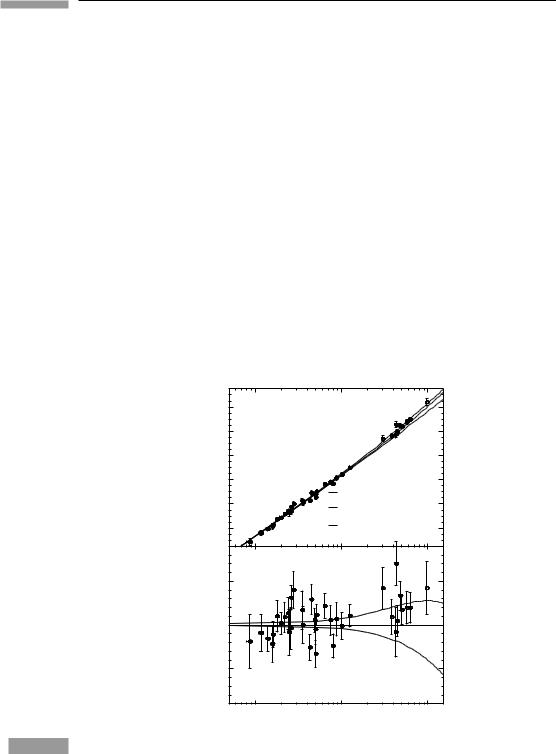
- •Contents
- •Preface to the second edition
- •Preface to the first edition
- •1 Special relativity
- •1.2 Definition of an inertial observer in SR
- •1.4 Spacetime diagrams
- •1.6 Invariance of the interval
- •1.8 Particularly important results
- •Time dilation
- •Lorentz contraction
- •Conventions
- •Failure of relativity?
- •1.9 The Lorentz transformation
- •1.11 Paradoxes and physical intuition
- •The problem
- •Brief solution
- •2 Vector analysis in special relativity
- •Transformation of basis vectors
- •Inverse transformations
- •2.3 The four-velocity
- •2.4 The four-momentum
- •Conservation of four-momentum
- •Scalar product of two vectors
- •Four-velocity and acceleration as derivatives
- •Energy and momentum
- •2.7 Photons
- •No four-velocity
- •Four-momentum
- •Zero rest-mass particles
- •3 Tensor analysis in special relativity
- •Components of a tensor
- •General properties
- •Notation for derivatives
- •Components
- •Symmetries
- •Circular reasoning?
- •Mixed components of metric
- •Metric and nonmetric vector algebras
- •3.10 Exercises
- •4 Perfect fluids in special relativity
- •The number density n
- •The flux across a surface
- •Number density as a timelike flux
- •The flux across the surface
- •4.4 Dust again: the stress–energy tensor
- •Energy density
- •4.5 General fluids
- •Definition of macroscopic quantities
- •First law of thermodynamics
- •The general stress–energy tensor
- •The spatial components of T, T ij
- •Conservation of energy–momentum
- •Conservation of particles
- •No heat conduction
- •No viscosity
- •Form of T
- •The conservation laws
- •4.8 Gauss’ law
- •4.10 Exercises
- •5 Preface to curvature
- •The gravitational redshift experiment
- •Nonexistence of a Lorentz frame at rest on Earth
- •The principle of equivalence
- •The redshift experiment again
- •Local inertial frames
- •Tidal forces
- •The role of curvature
- •Metric tensor
- •5.3 Tensor calculus in polar coordinates
- •Derivatives of basis vectors
- •Derivatives of general vectors
- •The covariant derivative
- •Divergence and Laplacian
- •5.4 Christoffel symbols and the metric
- •Calculating the Christoffel symbols from the metric
- •5.5 Noncoordinate bases
- •Polar coordinate basis
- •Polar unit basis
- •General remarks on noncoordinate bases
- •Noncoordinate bases in this book
- •5.8 Exercises
- •6 Curved manifolds
- •Differential structure
- •Proof of the local-flatness theorem
- •Geodesics
- •6.5 The curvature tensor
- •Geodesic deviation
- •The Ricci tensor
- •The Einstein tensor
- •6.7 Curvature in perspective
- •7 Physics in a curved spacetime
- •7.2 Physics in slightly curved spacetimes
- •7.3 Curved intuition
- •7.6 Exercises
- •8 The Einstein field equations
- •Geometrized units
- •8.2 Einstein’s equations
- •8.3 Einstein’s equations for weak gravitational fields
- •Nearly Lorentz coordinate systems
- •Gauge transformations
- •Riemann tensor
- •Weak-field Einstein equations
- •Newtonian limit
- •The far field of stationary relativistic sources
- •Definition of the mass of a relativistic body
- •8.5 Further reading
- •9 Gravitational radiation
- •The effect of waves on free particles
- •Measuring the stretching of space
- •Polarization of gravitational waves
- •An exact plane wave
- •9.2 The detection of gravitational waves
- •General considerations
- •Measuring distances with light
- •Beam detectors
- •Interferometer observations
- •9.3 The generation of gravitational waves
- •Simple estimates
- •Slow motion wave generation
- •Exact solution of the wave equation
- •Preview
- •Energy lost by a radiating system
- •Overview
- •Binary systems
- •Spinning neutron stars
- •9.6 Further reading
- •10 Spherical solutions for stars
- •The metric
- •Physical interpretation of metric terms
- •The Einstein tensor
- •Equation of state
- •Equations of motion
- •Einstein equations
- •Schwarzschild metric
- •Generality of the metric
- •10.5 The interior structure of the star
- •The structure of Newtonian stars
- •Buchdahl’s interior solution
- •10.7 Realistic stars and gravitational collapse
- •Buchdahl’s theorem
- •Quantum mechanical pressure
- •White dwarfs
- •Neutron stars
- •10.9 Exercises
- •11 Schwarzschild geometry and black holes
- •Black holes in Newtonian gravity
- •Conserved quantities
- •Perihelion shift
- •Post-Newtonian gravity
- •Gravitational deflection of light
- •Gravitational lensing
- •Coordinate singularities
- •Inside r = 2M
- •Coordinate systems
- •Kruskal–Szekeres coordinates
- •Formation of black holes in general
- •General properties of black holes
- •Kerr black hole
- •Dragging of inertial frames
- •Ergoregion
- •The Kerr horizon
- •Equatorial photon motion in the Kerr metric
- •The Penrose process
- •Supermassive black holes
- •Dynamical black holes
- •11.6 Further reading
- •12 Cosmology
- •The universe in the large
- •The cosmological arena
- •12.2 Cosmological kinematics: observing the expanding universe
- •Homogeneity and isotropy of the universe
- •Models of the universe: the cosmological principle
- •Cosmological metrics
- •Cosmological redshift as a distance measure
- •The universe is accelerating!
- •12.3 Cosmological dynamics: understanding the expanding universe
- •Critical density and the parameters of our universe
- •12.4 Physical cosmology: the evolution of the universe we observe
- •Dark matter and galaxy formation: the universe after decoupling
- •The early universe: fundamental physics meets cosmology
- •12.5 Further reading
- •Appendix A Summary of linear algebra
- •Vector space
- •References
- •Index

351 |
12.2 Cosmological kinematics: observing the expanding universe |
at a distance d can be inferred if we know the proper diameter D of the object transverse to the line of sight, θ = D/d. This leads to the definition of the angular diameter distance dA to an object anywhere in the universe:
dA = D/θ . |
(12.43) |
|
|
The dependence of dA on redshift z is explored in Exer. 12, § 12.6. The result is |
|
dA = Rer = (1 + z)−2dL, |
(12.44) |
where Re is the scale factor of the universe when the photon was emitted. The analogous expression to Eq. (12.42) is
dA = R0r/(1 + z) = |
|
%1 + −1 + |
|
|
|
|
z& + · · · . |
(12.45) |
H0 |
2 |
|
H2 |
|||||
|
z |
|
1 |
0 |
|
|
||
|
|
|
H˙ 0 |
|
|
|||
There are situations where we have in fact an estimate of the comoving diameter D of an emitter. In particular, the temperature irregularities in maps of the cosmic microwave background radiation (see below) have a length scale that is determined by the physics of the early universe.
Although we have provided small-z expansions for many interesting measures, it is important to bear in mind that astronomers today can observe objects out to very high redshifts. Some galaxies and quasars are known at redshifts greater than z = 6. The cosmological microwave background, which we will discuss below, originated at redshift z 1000, and is our best tool for understanding the Big Bang. Even so, the universe was already some 300 000 years old at that redshift. Sometime in the future, gravitational wave detectors may detect random radiation from the Big Bang itself, originating when the universe was only a fraction of a second old.
The derivation of Eq. (12.42) illustrates a point which we have encountered before: in the attempt to translate the nonrelativistic formula v = Hd into relativistic language, we were forced to re-think the meaning of all the terms in the equations and to go back to the quantities we can directly measure. If the study of GR teaches us only one thing, it should be that physics rests ultimately on measurements: concepts like distance, time, velocity, energy, and mass are derived from measurements, but they are often not the quantities directly measured, and our assumptions about their global properties must be guided by a careful understanding of how they are related to measurements.
The universe is accelerating!
The most remarkable cosmographic result since Hubble’s original work was the discovery that the expansion of the universe is not slowing down, but rather speeding up. This was done by essentially making a plot of the luminosity distance against redshift, but where luminosities are given in magnitudes. This is called the magnitude–redshift diagram, and we derive its low-z expansion in Exer. 13, § 12.6. Two teams of astronomers, called the

352 |
Cosmology |
High-Z Supernova Search Team (Riess et al., 1998) and the Supernova Cosmology Project (Perlmutter et al., 1999), respectively, used supernova explosions of Type Ia as standard candles out to redshifts of order 1. Although there was considerable scatter among the data points, both teams found that the best fit to the data was a universe that was speeding up and not slowing down. The data from the High-Z Team are shown in Fig. 12.3. See Filippenko (2008) for a full discussion.
The top diagram shows the flux (magnitude) measurement for each of the supernovae in the sample, along with error bars. The trend seems to curve upwards, meaning that at high redshifts the supernovae are dimmer than expected. This would happen if the universe were speeding up, because the supernovae would simply be further away than expected. Three possible fits are shown, and the best one has a large positive cosmological constant, which we shall see below is the simplest way, within Einstein’s equations, that we can accommodate acceleration. The lower diagram shows the same data but plotting only the residuals from the fit to a flat universe. This shows more clearly how the data favor the curve for the accelerating universe.
These studies were the first strong evidence for acceleration, but by now there are several lines of investigation that lead to the same conclusion. Astronomers initially resisted the conclusion, because it undermines a basic assumption we have always made about gravity, that it is universally attractive. If the energy density of the universe exerts attractive gravity,
|
44 |
|
|
|
MLCS |
|
|
|
42 |
|
|
g) |
40 |
|
|
-M (ma |
|
|
|
38 |
|
|
|
m |
|
ΩM = 0.24, |
ΩΛ = 0.76 |
|
36 |
||
|
ΩM = 0.20, |
ΩΛ = 0.00 |
|
|
|
||
|
34 |
ΩM = 1.00, ΩΛ = 0.00 |
|
|
0.5 |
|
|
(mag) |
0.0 |
|
|
(m-M) |
|
|
|
|
|
|
|
|
–0.5 |
|
|
|
0.01 |
0.10 |
1.00 |
|
|
z |
|
Figure 12.3 The trend of luminosity versus redshift for Type Ia supernovae is fit best with an accelerating universe. The lower part of this curve determines H0, the upper part demonstrates acceleration. (High-Z Supernova Search Team: Riess, et al, 1998.)
